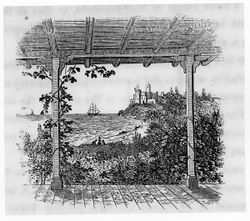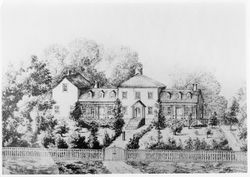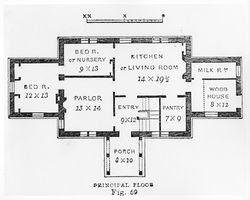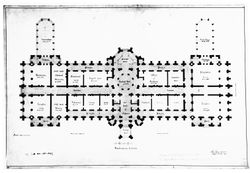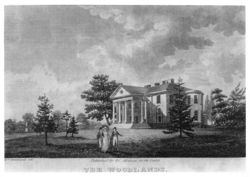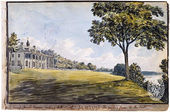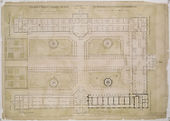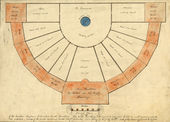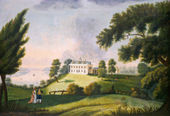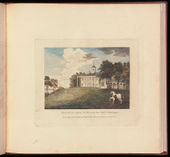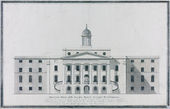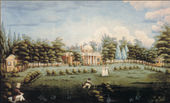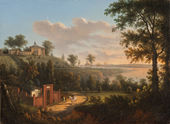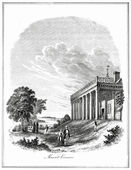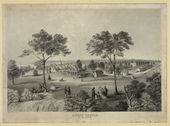Difference between revisions of "Portico"
| Line 5: | Line 5: | ||
Two images exemplify the importance of the [[piazza]], [[veranda]], [[porch]], and portico in creating and framing views of the garden and landscape. The first is a drawing of [[York Island]], Long Island, by [[William Russell Birch]] (1808), who explained that the [[view]] was taken from the [[piazza]], a place from which one could see "innumerable [[seat]]s, spreading over an extensive country which glittered as the sun arose" [Fig. 1]. The second is from [[A. J. Downing]]'s book on wooden [[picturesque]] houses, ''The Architecture of Country Houses'' (1850) [Fig. 2]. Both illustrated views from the bracketed [[piazza]], or [[veranda]], as [[A. J. Downing|Downing]] preferred to call it, out to the distant [[prospect]]. | Two images exemplify the importance of the [[piazza]], [[veranda]], [[porch]], and portico in creating and framing views of the garden and landscape. The first is a drawing of [[York Island]], Long Island, by [[William Russell Birch]] (1808), who explained that the [[view]] was taken from the [[piazza]], a place from which one could see "innumerable [[seat]]s, spreading over an extensive country which glittered as the sun arose" [Fig. 1]. The second is from [[A. J. Downing]]'s book on wooden [[picturesque]] houses, ''The Architecture of Country Houses'' (1850) [Fig. 2]. Both illustrated views from the bracketed [[piazza]], or [[veranda]], as [[A. J. Downing|Downing]] preferred to call it, out to the distant [[prospect]]. | ||
| − | Various treatises used all of these terms interchangeably in their definitions. [[Alexander Jackson Davis]] and [[A. J. Downing|Downing]] also used the term 'umbrage' to refer to the same feature on a house, implying a place of shade.<ref> William Pierson, Jr., traces the origins of the feature, specifically found in [[Alexander Jackson Davis]] and [[A. J. Downing|A. J. Downing]]'s work, to the awning or canopy partaking of an oriental flavor. In general, its origin was a semi-enclosed outdoor space that was not at all architectural but was related to the ornamental canopy or tent. This connection might explain why the detail flourished during the high romantic period in American architecture. See Pierson, American Buildings and Their Architects: Technology and the Picturesque, the Corporate and the Early Gothic Styles, vol. 2 (New York: Doubleday, 1978), 300-304, [https://www.zotero.org/groups/54737/items/itemKey/J8FITVZG/q/Pierson| view on Zotero.]</ref> [[Mary Elizabeth Latrobe]] mentioned that in New Orleans the [[piazza]] was known as the gallery. Contrasting usage of these words sometimes could offer distinctions. Rev. Manasseh Cutler, for example, in his description of [[Monticello]], said that the term "portico" refers to smaller entrance porches and the term "[[piazza]]" to extended covered walkways stretching perpendicularly from the porticos. For the purposes of this essay, each of the four key terms will be described in turn, highlighting any specific meanings that have been attributed to them. | + | Various treatises used all of these terms interchangeably in their definitions. [[Alexander Jackson Davis]] and [[A. J. Downing|Downing]] also used the term 'umbrage' to refer to the same feature on a house, implying a place of shade.<ref> William Pierson, Jr., traces the origins of the feature, specifically found in [[Alexander Jackson Davis]] and [[A. J. Downing|A. J. Downing]]'s work, to the awning or canopy partaking of an oriental flavor. In general, its origin was a semi-enclosed outdoor space that was not at all architectural but was related to the ornamental canopy or tent. This connection might explain why the detail flourished during the high romantic period in American architecture. See Pierson, American Buildings and Their Architects: Technology and the Picturesque, the Corporate and the Early Gothic Styles, vol. 2 (New York: Doubleday, 1978), 300-304, [https://www.zotero.org/groups/54737/items/itemKey/J8FITVZG/q/Pierson| view on Zotero.]</ref> <span id="Latrobe_cite">[[Mary Elizabeth Latrobe]] ([[#Latrobe|view text]])mentioned that in New Orleans the [[piazza]] was known as the gallery. Contrasting usage of these words sometimes could offer distinctions. Rev. Manasseh Cutler, for example, in his description of [[Monticello]], said that the term "portico" refers to smaller entrance porches and the term "[[piazza]]" to extended covered walkways stretching perpendicularly from the porticos. For the purposes of this essay, each of the four key terms will be described in turn, highlighting any specific meanings that have been attributed to them. |
[[File:1732.jpg|thumb|Fig. 3, [[Batty Langley|Batty]] and [[Thomas Langley]], "Four Examples of Arcades for Piazza's", 1747.]] | [[File:1732.jpg|thumb|Fig. 3, [[Batty Langley|Batty]] and [[Thomas Langley]], "Four Examples of Arcades for Piazza's", 1747.]] | ||
In 1828, [[Frances Milton Trollope]], the acerbic critic of American art and architecture, described the [[piazza]] as a "luxury almost universal in the country houses of America." Indeed it was a feature found throughout the colonies and dates from the late eighteenth to the mid-nineteenth centuries. From Massachusetts to the lower Mississippi Valley, examples are found on both private and public buildings. The feature was adapted to various styles with appropriate detailing and ornamentation. The [[piazza]] was a projecting [[porch]] or connecting passage that was identifiable in neoclassical [[plantation]] houses in the South, as well as in the Gothic revival suburban cottages of New Jersey and Pennsylvania. There were countless variations ranging from the simple wooden post-and-lintel type, to stone-[[arch]]ed [[piazza]]s depicted by [[Batty Langley]] [Fig. 3] and mentioned in 1839 at [[Laurel Hill Cemetery]] in Philadelphia. | In 1828, [[Frances Milton Trollope]], the acerbic critic of American art and architecture, described the [[piazza]] as a "luxury almost universal in the country houses of America." Indeed it was a feature found throughout the colonies and dates from the late eighteenth to the mid-nineteenth centuries. From Massachusetts to the lower Mississippi Valley, examples are found on both private and public buildings. The feature was adapted to various styles with appropriate detailing and ornamentation. The [[piazza]] was a projecting [[porch]] or connecting passage that was identifiable in neoclassical [[plantation]] houses in the South, as well as in the Gothic revival suburban cottages of New Jersey and Pennsylvania. There were countless variations ranging from the simple wooden post-and-lintel type, to stone-[[arch]]ed [[piazza]]s depicted by [[Batty Langley]] [Fig. 3] and mentioned in 1839 at [[Laurel Hill Cemetery]] in Philadelphia. | ||
| Line 195: | Line 195: | ||
: "The mansion house itself appears venerable and convenient[.] A lofty '''portico''' ninety-six feet in length, Supported by Eight [[pillar]]s, has a pleasing effect when viewed from the water." | : "The mansion house itself appears venerable and convenient[.] A lofty '''portico''' ninety-six feet in length, Supported by Eight [[pillar]]s, has a pleasing effect when viewed from the water." | ||
| + | |||
| + | |||
| + | * <div id="Latrobe"></div>[[Mary Elizabeth Latrobe|Latrobe, Mary Elizabeth]], April 18, 1820, describing the home of [[Benjamin Henry Latrobe]], New Orleans, La. (1951: 181)<ref name="Latrobe_1951"> Benjamin Henry Latrobe. ''Impressions Respecting New Orleans: Diaries and Sketches, 1818–1820'', ed. Samuel Wilson (New York: Columbia University Press, 1951), [https://www.zotero.org/groups/54737/items/itemKey/MJS5EE69/q/latrobe view on Zotero]. </ref> [[#Latrobe_cite|back up to history]] | ||
| + | |||
| + | : "Our lot is 360 feet and 64 front, the house is up 16 steps with a [[Piazza]] (or Gallery as they call them here) the whole length of the house front and back, there is no entry or passage like our Baltimore houses." | ||
===Citations=== | ===Citations=== | ||
Revision as of 15:35, July 1, 2015
History
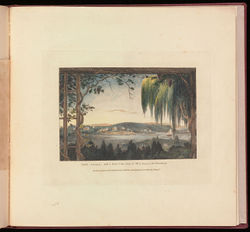
Several words were used synonymously to describe covered walks or spaces supported by columns or piers and attached to, or to part of, a building. This architectural feature spoke to the interrelatedness of architecture and gardens, a relationship that grew out of the romantic interest in landscape characterizing the aesthetics of the eighteenth and nineteenth centuries.
Two images exemplify the importance of the piazza, veranda, porch, and portico in creating and framing views of the garden and landscape. The first is a drawing of York Island, Long Island, by William Russell Birch (1808), who explained that the view was taken from the piazza, a place from which one could see "innumerable seats, spreading over an extensive country which glittered as the sun arose" [Fig. 1]. The second is from A. J. Downing's book on wooden picturesque houses, The Architecture of Country Houses (1850) [Fig. 2]. Both illustrated views from the bracketed piazza, or veranda, as Downing preferred to call it, out to the distant prospect.
Various treatises used all of these terms interchangeably in their definitions. Alexander Jackson Davis and Downing also used the term 'umbrage' to refer to the same feature on a house, implying a place of shade.[1] Mary Elizabeth Latrobe (view text)mentioned that in New Orleans the piazza was known as the gallery. Contrasting usage of these words sometimes could offer distinctions. Rev. Manasseh Cutler, for example, in his description of Monticello, said that the term "portico" refers to smaller entrance porches and the term "piazza" to extended covered walkways stretching perpendicularly from the porticos. For the purposes of this essay, each of the four key terms will be described in turn, highlighting any specific meanings that have been attributed to them.
In 1828, Frances Milton Trollope, the acerbic critic of American art and architecture, described the piazza as a "luxury almost universal in the country houses of America." Indeed it was a feature found throughout the colonies and dates from the late eighteenth to the mid-nineteenth centuries. From Massachusetts to the lower Mississippi Valley, examples are found on both private and public buildings. The feature was adapted to various styles with appropriate detailing and ornamentation. The piazza was a projecting porch or connecting passage that was identifiable in neoclassical plantation houses in the South, as well as in the Gothic revival suburban cottages of New Jersey and Pennsylvania. There were countless variations ranging from the simple wooden post-and-lintel type, to stone-arched piazzas depicted by Batty Langley [Fig. 3] and mentioned in 1839 at Laurel Hill Cemetery in Philadelphia.
In texts and images related to American gardens of the period under study, although several imported treatises traced "piazza" back to covered walkways that surrounded the square, the term has not been associated with the Italian term for a medieval or renaissance square. It was generally described as two related but somewhat distinctive appendages to buildings. First, the piazza was attached porch-like to a façade so that three sides of the piazza projected out from the building [Fig. 4], or the sides were recessed into the structure, as on the main façade of the U.S. Naval Asylum in Philadelphia [Fig. 5]. At other times it appeared on more than one façade [Fig. 6]. In New Orleans one house was described as having piazzas on all four sides. Both one- and two-story piazzas were also built. Second, "piazza" also referred to a covered walkway embedded between two buildings and acting as a connecting link. A single- or even double-height piazza, such as that described in 1799 on a property in Richmond, Va., provided either an entrance or transition space from interior architecture to exterior space. In the case of the University of Virginia, piazzas linked the entire range of houses around the lawn, and they served as transitional spaces leading to the lawn [Fig. 7].
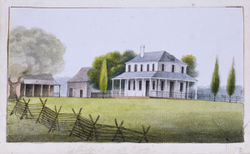
The piazza's basic structure consisted of a roof supported by pillars or columns. A piazza might be walled on each side with Venetian blinds or, as Harriet Martineau described one in 1835, "draperied with vines." Flooring was stone, flag, wooden planks, or gravel. The roof was generally either flat or peaked. James E. Teschemacher (1835), however, described and illustrated a piazza with a concave roof formed of painted floor cloth fastened on wooden rafters, which were supported by wooden arches. Several images depict the piazza at ground level opening directly out into the landscape. Some examples, however, describe broad and spacious flights of stairs leading from the piazza and 'descending into the garden.' At Thomas Jefferson's Monticello (Charlottesville) and Poplar Forest (Bedford County, Va.), the piazzas had no immediate access to the ground but instead were raised, balcony-like structures overlooking the garden. Even if not a physical link, the visual connection to the exterior remained critical to the function of this feature.
The nineteenth-century architect William H. Ranlett, who used them often in his residential design, praised piazzas for their "very expressive" purpose. They functioned as sitting areas that were furnished with couches, chairs, and sometimes tables where one could take a meal. They were used to provide a place for walking or sitting and enjoying the breeze, shade and coolness; they also served to keep the sun from warming the interior of the house. Since the feature was designed to provide views in addition to protection from the sun, orientation of the piazza had to be planned with regard to the sun and surrounding environment. At Hyde Park, a visitor in 1830 mentioned that one piazza was open to the Hudson River and the other looked over a beautiful lawn, suggesting that the view dictated where the piazzas might be located.
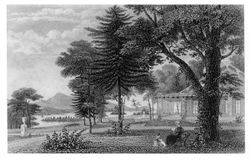
Ranlett was emphatic when he decreed that a "dwelling should always have one or more of them [piazzas]." He regarded the absence of a piazza on a new house an indication of ignorance, niggardliness, and narrow- minded views. Downing (1850) went so far as to proclaim the lack of a piazza or veranda in any but the most utilitarian structure as "unphilosophical and false in taste!" He claimed that it was a resting place, lounging spot, and place of social resort of the whole family across nearly the entire extent of the United States [Fig. 8].
Appearing only in the mid-nineteenth century in treatise literature with any frequency, the term "veranda" (also spelled verandah) was used in 1748 in Pehr Kalm's Travels in North America, in which he described small balconies or porches on houses.[2] Many visual and textual examples indicate that veranda served as an intermediary space between a house and its garden. Downing described it as an overhanging or low roof supported by an open colonnade or framework. He recommended that it have a gravel or wooden surface rising six to eight inches above the surrounding ground. Climbing plants often covered verandas. Some writers refer to arbor-verandas and also mention the latticework that provided screening and support for climbing plants. Ornamental brackets and bargeboards also added to the decorations of the veranda.
The term was, as mentioned, often used interchangeably with "porch," "portico," and "piazza." Ranlett sometimes distinguished between the two, using "piazza" for a projecting roof and "veranda" for an overhanging roof. Downing used the term "porch" to identify that part of the veranda where steps led from the ground to the entryway. He also used the term "pavilion" synonymously with "veranda".
Downing (1850) expounded at length on the meaning of the veranda, which he saw as a truly American feature not found in European architecture.[3] Always concerned with identifying a national style, he believed that the veranda, in addition to providing shade and transitional zone from house to garden, was not simply ornamental but useful and "connected with the life of the owner of the cottage." Its presence expressed the ownership of a family exhibiting rural taste and a love of [picturesque] character, a family "at home in the country."

Although the veranda was an architectural feature found in the colonial and early national periods, it became a key component of asymmetrical picturesque design for both landscape and architecture in the 1840s.[4] Many illustrations for house pattern books by Downing and his followers depicted plans and elevations in various romantic styles that feature the veranda as an element in a new spatial organization that experimented with the interweaving of interior and exterior space. In his Treatise (1849) Downing wrote, "architectural beauty must be considered conjointly with the beauty of the landscape or situation," and "if properly designed and constructed . . . will even serve to impress a character on the surrounding landscape."[5] That the frontispiece to his Treatise illustrated the veranda at Blithewood underscores the importance of this theoretical stance. Another drawing of Blithewood [Fig. 9] by Alexander Jackson Davis presented, from the house and through the semi-enclosed space of the veranda, the view of the landscape toward the river, exemplifying the interpenetration of space that became for Davis and Downing an important characteristic of their architecture. Architectural historians have written about the veranda as a major component in picturesque architecture and a mark of distinction between American and English houses of the Gothic revival.[6]
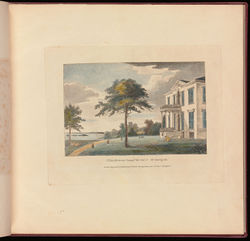
The term "porch," as the 1828 dictionary entry by Noah Webster indicates, refers to a roofed architectural element often supported by columns or piers, either attached to a building or existing as an independent garden structure. During the colonial and early Republic periods three kinds of porches were evident throughout America. First, the porch was either an open or enclosed projecting roofed area of a building that sheltered a doorway or entrance [Fig. 10]. Since most gardens were situated next to the house, a porch was often a point of access from the house to the ornamental grounds. Eliza Caroline Burgwin Clitherall (active 1801) depicted such a porch at the Hermitage in Wilmington, N.C. [Fig. 11].
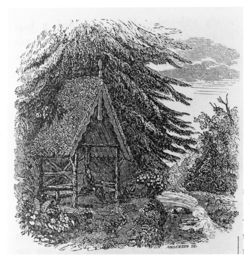
The second meaning of the term referred to a covered sitting and viewing area that was either attached to the building or was free-standing. In describing the use of porches as "decorative marks to the entrances of scenes" (akin to those of a theater proscenium), J. C. Loudon was referring to their use as embellished shelters over benches or seats placed in the garden. Downing's description of the rustic porch at Montgomery Place, on the Hudson River in Dutchess County, N.Y., argues that in addition to punctuating or shaping garden scenery, as Loudon recommended, porches, if appropriately placed and decorated, offered a way to situate a seat in the landscape thereby directing a view or prospect [Fig. 12]. Its function also allowed those seated to observe the landscape in all kinds of weather, as described in 1749 by Pehr Kalm. Downing's porches make clear the function of the porch as a mediator between interior and exterior realms. He praised porches that were covered with vegetation for easing the transition from outside to inside, and for providing evidence of the cultivated domesticity within the home [Fig. 13].
The third kind of porch is described by Downing as the carriage porch, or porte cochre, where in a grand home the arriving guests drew up under an architectural canopy for shelter. John Notman similarly inscribed the term porte cochre on his unexecuted design for the Smithsonian Institution in Washington, D.C. [Fig. 14]. He includes porches for the side entrances and piazzas for galleries running along the façades.
The term "portico" was also used when referring to a covered space that was supported by columns or piers and was attached to a building. Semantic distinctions were made, however, using "portico" to identify the principal entrances to the house and "piazza" for the extended side porches. The higher status of the portico, as opposed to piazza, veranda, or porch, was emphasized by its frequent modification by adjectives such as "handsome," "noble," and "elegant" [Fig. 15]. The word "portico" seems not to have been used to refer to covered walkways that linked separate buildings, as is made clear in the distinction in 1777 regarding the College of William and Mary in Williamsburg, Va.

Margaret Bayard Smith in 1828 said the portico at President James Madison's plantation, Montpelier, commanded a view, "a beautiful scene," of extensive lawns and forests, where viewers walked through the portico until twilight when the landscape was no longer visible [Fig. 16]. John Mason recalled the portico at George Mason's Gunston Hall, near Mason Neck, Va., from which "you descended directly into an extensive garden." Downing's 1849 comments conveyed a similar meaning, suggesting that the portico served to connect the building, visually and also physically, "by gradual transition with the ground about it."

The portico served as a focal, as well as a viewing, point. Lewis Miller, for example, in 1849 wrote that at Mount Vernon the "lofty portico . . . has a pleasing effect when viewed from the water" [Fig. 17]. Often the portico was distinguished from the building it ornamented by its material, creating a distant focus for the spectator from the garden or surrounding landscape. A brick building was sometimes ornamented with a contrasting white stone or painted wood portico. As David Bailie Warden noted in 1816, such a feature made a house "admirably adapted to the American climate."

Porticos generally were dressed in a classical style, meaning that classical columns supported the low-pitched roof and the front was finished with an entablature and pediment. Many descriptions specified Doric (e.g., Centre Square in Philadelphia), Tuscan (e.g., the Woodlands near Philadelphia), or Corinthian (e.g., Ranlett's design for a house in Italian bracketed style). Two notable exceptions to the classical style, however, are well known. William Buckland's fanciful octagonal porch at Gunston Hall (1755-58) had ogee arches and is thought to have been inspired by the writings of Batty Langley, who promoted Gothic and chinoiserie details for architectural decoration [Fig. 18]. Benjamin Henry Latrobe's Gothic design for Sedgeley, near Philadelphia (1799) [Fig. 19], which is considered one of the earliest Gothic revival houses in America, had tall slender posts supporting the roof.
Thus, two points are important in the history of these terms: First, these architectural elements served to elide the boundaries of the garden and building by linking interior and exterior space both visually and physically. Second, the associative values of refinement and domesticity, and even national progress, were read into the forms. --Therese O'Malley
Texts
Usage
- Anonymous, 1737, describing in the St. Philip's Parish Vestry Book St. Philip's Parish, Charleston, S.C. (quoted in Lounsbury 1994: 287) [7]
- "[Workmen recommended the constructions of] a large Cornish under ye eves & round ye Porticoes."
- Carroll, Charles (the Barrister), July 2, 1767, describing Mount Clare, plantation of Charles and Margaret Tilghman Carroll, Baltimore, Md. (quoted in Trostel 1981: 34)[8]
- "The Plan is for a Portico or Colonade to be Joined to the Front of a House and Project Eight Feet from it, An Arch at Both Ends, for a Passage through it, to Spring from Pilasters of Stone Joined to the End Pillars of the front of the Portico and the two three Quarter Round Columns, I think they Call them, that Run up Close to the wall of the House."
- Anonymous, 1769, describing in the Georgia Gazette a proposed Presbyterian meetinghouse in Savannah, Ga. (quoted in Lounsbury 1994: 287) [7]
- "[The meetinghouse was to be] 80 feet long by 47 feet wide . . . with a handsome light steeple in proportion to the frame, a portico at one end of 50 by 10 feet."
- Fithian, Philip Vickers, March 18, 1774, describing Nomini Hall, Westmoreland County, Va. (1943: 107)[9]
- "The North side [of Nomini Hall] I think is most beautiful of all; In the upper Story is a Row of seven Windows with eighteen Lights a piece; and below six windows, with the like number of lights; besides a large Portico in the middle, at the sides of which are two Windows each with eighteen Lights."
- [Hazard, Ebenezer, May 31, 1777, describing the College of William and Mary, Williamsburg, Va. (quoted in Shelley 1954: 405)[10]
- "The Wings are on the West Front, between them is a covered Parade, which reaches from the one to the other; the Portico is supported by Stone Pillars."
- Clark, Jonathan, 1786, describing a farm in the Shenandoah Valley, Va. (quoted in Lounsbury 1994: 287) [7]
- "[There was a] fraimed dwelling house 26 by 20 . . . and a portico the length of the fraimed house five feet wide."
- Brissot de Warville, J. P., 1792, describing Mount Vernon, plantation of George Washington, Fairfax County, Va. (quoted in Lockwood 1934: 2:61)[11]
- "I hastened to arrive at Mount Vernon. . . . after having passed over two hills, you discover a country house of an elegant and majestic simplicity. . . . This house overlooks the Potomack, enjoys an extensive prospect, has a vast and elegant portico on the front next to the river, and a convenient distribution of the apartments within."
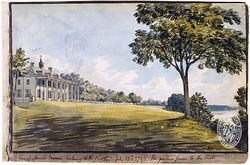
- Weld, Isaac, 1795, describing Monticello, plantation of Thomas Jefferson, Charlottesville, Va. (1799: 207)[12]
- "In the center is another very spacious apartment, of an octagon form, reaching from the front to the rear of the house, the large folding glass doors of which, at each end, open under a portico."
- Latrobe, Benjamin Henry, July 19 1796, describing Mount Vernon, plantation of George Washington, Fairfax County, Va. (1977: 1:163) [13]
- "The House is connected with the Kitchen offices by arcades. . . . Along the other front is a portico supported by 8 square pillars, of good proportions and effect." [Fig. 29]
- Anonymous, 1803, describing in the Virginia Herald a property for rent in Fredericksburg, Va. (quoted in Lounsbury 1994: 286)[7]
- "commodious close porch in front, and an open portico in the rear."
- Anonymous, August 9, 1805, describing in the Virginia Herald a property for rent in Stafford County, Va. (Colonial Williamsburg Foundation; hereafter CWF)
- "FOR LEASE, A Lot of Land. . . . On the above lot there is two convenient Dwelling houses, situate near each other, with two rooms on a floor and a portico to each, the whole length of the house, and convenient closets."
- Scott, Joseph, 1806, describing Centre Square and Waterworks, Philadelphia, Pa. (p. 25)[14]
- "The water-works of Philadelphia are the most extensive of their kind of any in America. . . . The water is discharged into a circular aqueduct, extending along Chestnut and Broad streets, into the middle of Market-street, in the centre square. . . . The building in the centre square, is a square of sixty feet, with a Doric portico on the east and west fronts. From its centre rises a circular tower, forty feet in diameter. It is covered by a dome. The tower contains the engine and reservoir . . . large enough to contain 20,000 gallons, all the chimnies of the house, which form a marble pedestal, on the summit. The shafts of the columns of the porticos, consist each of one solid block of marble, 14 feet 9 inches in length, and two feet nine inches in diameter, at the base."[See Fig. 15]
- Drayton, Charles, November 2, 1806, describing the Woodlands, seat of William Hamilton, near Philadelphia, Pa. (Drayton Hall, Charles Drayton Diaries, 1784-1820, typescript)
- "The Garden consists of a large verdant lawn surrounded by a belt or walk, & shrubbery for some distance. the outer side of the walk is adorned here & there, by scattered forest trees, thick & thin. It is bounded, partly as is described—partly by the Schylkill [sic] & a creek exhibiting a Mill & where it is scarcely noticed, by a common post and rail. The walk is said to be a mile long—perhaps it is something less. one is led in to the garden from the portico, to the east and lefthand. or from the park, by a small gate contiguous to the house. traversing this walk, one sees many beauties of landscape—also a fine statue, symbol of Winter & age." [Fig. 30]
- Martin, William Dickinson, May 20, 1809, describing Philadelphia, Pa. (CWF)
- "The building in Centre Square, is Sixty feet in every direction; having a Doric portico in front, to the East & West."
- Foster, Sir Augustus John, 1812, describing Monticello, plantation of Thomas Jefferson, Charlottesville, Va. (1954: 144) [15]
- "The house has two porticoes of the Doric order, though one of them was not quite completed, and the pediment had in the meanwhile to be supported on the stems of four tulip trees, which are really, when well grown, as beautiful as the fluted shafts of Corinthian pillars. They front north and south."
- Warden, David Bailie, 1816, describing Riversdale, estate of George and Rosalie Stier Calvert, Prince George's County, Md. (p. 156)[16]
- "The establishment of George Calvert, Esq. at Bladensburg, attracts attention. His mansion, consisting of two stories, seventy feet in length, and thirty-six in breadth, is admirably adapted to the American climate. On each side there is a large portico, which shelters from the sun, rain, or snow."
- Anonymous, September 30, 1820, describing in the Virginia Herald a property for rent in Culpeper County, Va. (CWF)
- "I will sell my tavern establishment . . . consisting of . . . A large and commodious house with four rooms below stairs and eight above, with two large porticoes—a new smoke house, a new ice house."
- Silliman, Benjamin, 1824, describing Monte Video, property of Daniel Wadsworth, Avon, Conn. (p. 12)[17]
- "To the west, the lawn rises gradually from the water, until it reaches the portico of the house, near the brow of the mountain, beyond which, the western valley is again seen."
- Ticknor, George, December 16, 1824, in a letter to William H. Prescott, describing Montpelier, plantation of James Madison, Montpelier Station, Va. (quoted in Jones 1957: 7)[18]
- "We were received with a good deal of dignity and much cordiality, by Mr. and Mrs. Madison, in the portico, and immediately placed at ease."
- Douglass, Frederick, 1825, describing Wye House, estate of Col. Edward Lloyd, Talbot County, Md. ([1855] 1987: 47) [19]
- "The great house itself was a large, white, wooden building, with wings on three sides of it. In front, a large portico, extending the entire length of the building, and supported by a long range of columns, gave to the whole establishment an air of solemn grandeur."
- Smith, Margaret Bayard, August 2, 1828, describing the University of Virginia, Charlottesville, Va. (1906: 226) [20]
- "The rotunda is in form and proportioned like the Pantheon at Rome. It has a noble portico,— the pillars, cornice, &c of the Corinthian."
- Smith, Margaret Bayard, August 17, 1828, describing Montpelier, plantation of James Madison, Montpelier Station, Va. (1906: 233, 235-36)[20]
- "We were at first conducted into the Drawing room, which opens on the back Portico and thus commands a view through the whole house, which is surrounded with an extensive lawn, as green as in spring; the lawn is enclosed with fine trees, chiefly forest, but interspersed with weeping willows and other ornamental trees, all of most luxuriant growth and vivid verdure. It was a beautiful scene! . . . After dinner, we all walked in the Portico, (or piazza, which is 60 feet long, supported on six lofty pillars) until twilight." [See Fig. 16]
- Anonymous, June 1829, describing Sedgeley, seat of James C. Fisher, near Philadelphia, Pa. (The Casket 4: 265)
- "The mansion was designed and erected under the superintendance of the late Mr. Latrobe, and has been much admired for its architectural beauty. The style is Gothic, with a portico front and rear, supported by eight columns each. It presents a length of seventy-five feet, and is well adapted in the arrangement of the interior for a gentleman's residence." [See Fig. 19]
- Mason, General John, c. 1830, describing Gunston Hall, seat of George Mason, Mason Neck, Va. (quoted in Rowland 1964: 1:98)ref>Rowland, Kate Mason. 1964. The Life of George Mason: 1725-1792, 2 vols. (New York: Russell and Russell, 1964), view on Zotero.</ref>
- "The south front looked to the river; from an elevated little portico on this front you descended directly into an extensive garden, touching the house on one side."
- Featherstonhaugh, George William, August 18 and 19 1837, describing Fort Hill, seat of John C. Calhoun, Clemson, S.C. (quoted in Jones 1957: 126)[18]
- "After partaking of an excellent dinner we adjourned for the evening to the portico, where with the aid of a guitar, accompanied by a pleasing voice, and some capital curds and cream, we prolonged a most agreeable conversazione until a late hour. . . .
- "On our return to Fort Hill, the family again assembled in the portico to pass a most agreeable evening."
- Buckingham, James Silk, 1842, describing Red Sulphur Springs, Va. (CWF)
- "Behind the "Bachelor's Row," and on the upper part of the hill is an imposing edifice of brick, called "Society Hall." It is built of two stories, with a fine portico of twelve feet wide, running the whole length of the front, and a terrace of twenty feet wide beyond this."
- Anonymous, August 1848, describing Riversdale, estate of George and Rosalie Stier Calvert, Prince George's County, Md. (American Farmer 4: 53)
- "The main building is 68 by about 50 feet, with an elegant Portico on its northern [front], and a Piaza [sic], running its entire length, on its southern front, each constructed with due regard to classic and architectural propriety."
- Miller, Lewis, June 5, 1849, describing Mount Vernon, plantation of George Washington, Fairfax County, Va. (c. 1850: 108) [21]
- "The mansion house itself appears venerable and convenient[.] A lofty portico ninety-six feet in length, Supported by Eight pillars, has a pleasing effect when viewed from the water."
- Latrobe, Mary Elizabeth, April 18, 1820, describing the home of Benjamin Henry Latrobe, New Orleans, La. (1951: 181)[22] back up to history
- "Our lot is 360 feet and 64 front, the house is up 16 steps with a Piazza (or Gallery as they call them here) the whole length of the house front and back, there is no entry or passage like our Baltimore houses."
Citations
- [Dézallier d’Argenville, A.-J.], 1712, The Theory and Practice of Gardening ([1712] 1969: 72) [23]
- "A PORTICO . . . being the Entrance in Front of a Summer-House, Salon, or Arbor of Latticework, and is generally adorn'd with a handsome Cornice and Frontispiece, supported by Pilasters or Peers; or else it is a long Decoration of Architecture placed against a Wall, or at the Entrance of a Wood, where the Advances and Returns are but inconsiderable.
- "ARBORS, Cabinets, and Porticos of Latticework, are commonly made use of to terminate a Garden in the City, and to shut out the Sight of Walls, and other disagreeable Objects; this Kind of Decoration making a handsome Sight, and serving very well to conclude the Prospect of a principal Walk."

- Gibbs, James, 1728, A Book of Architecture (n.p.) [24]
- "The Plan, Upright and Section of a Building of the Dorick Order in the form of a Temple, made for a Person of Quality, and proposed to have been placed in the Center of four Walks; so that a Portico might front each Walk." [Fig. 31]
- Chambers, Ephraim, 1741-43, Cyclopaedia (2:n.p.)[25]
- "PIAZZA, in building, popularly called piache, an Italian name for a portico, or covered walk, supported by arches. See PORTICO.
- "The word literally signifies a broad open place or square; whence it also became applied to the walks or portico's around them. . . .
- "PORTICO, in architecture, a kind of gallery on the ground; or a piazza encompassed with arches supported by columns, where people walk under covert. See PIAZZA. . . .
- "PORTICO....
- "The roof is usually vaulted, sometimes flat. The ancients called it lacunar. See LACUNAR, VAULT, &c.
- "Though the word portico be derived from porta, gate, door; yet it is applied to any disposition of columns which form a gallery, without any immediate relation to doors or gates.
- "The most celebrated portico's of antiquity were those of Solomon's temple, which formed the atrium or court, and encompassed the sanctuary: that of Athens, built for the people to divert themselves in, and wherein the philosophers held their disputes and conversations; which occasioned the disciples of Zeno to be called stoics....
- "Among the modern portico's, the most celebrated is the piazza of St. Peter of the Vatican.— That of Covent-Garden, London, the work of Inigo Jones, is also much admired."
- Johnson, Samuel, 1755, A Dictionary of the English Language (2:n.p.) [26]
- Ware, Isaac, 1756, Complete Body of Architecture (p. 31) [27]
- "PORTICO.
- "A place for walking under shelter, raised with arches, in the manner of a gallery. The portico is usually vaulted, but it has sometimes a soffit, or ceiling. The portico is a piazza encompassed with arches raised upon columns, and covered over head in any manner. The word seems to refer to the gate or entrance of some place, porta in Latin signifying a gate; but it is appropriated to a disposition of columns, forming this kind of gallery, and has no relation to the openings."
- Salmon, William, 1762, Palladio Londinensis (n.p.)[28]
- "Piazza, in Architecture, commonly called Piache, an Italian Name for a Portico; it signifies a broad open Place or Square, whence it became applied to Walks or Porticos of Pillars around them, like those of Covent Garden, the Royal Exchange, &c."
- Sheridan, Thomas, 1789, A Complete Dictionary of the English Language (n.p.)[29]
- Marshall, William, 1803, On Planting and Rural Ornament (1:266) [30]
- "IN extensive grounds, RETREATS, more especially in the remoter parts, are in a degree requisite; and, if they be seen, they ought to harmonize with the views in which they appear; and, of course, the more polished the scene, the more ornamental should be the Retreat,—whether it be the Room, the Portico, or the more simple Alcove."
- Loudon, J. C., 1826, An Encyclopaedia of Gardening (p. 356)[31]
- "1809. Porches and porticoes . . . are sometimes employed as decorative marks to the entrances of scenes; and sometimes merely as roofs to shelter seats or resting benches." [See Fig. 27]
- Webster, Noah, 1828, An American Dictionary of the English Language (n.p.) [32]
- "PORTICO, n. [It. portico; L. porticus, from porta or portus.]
- "In architecture, a kind of gallery on the ground, or a piazza encompassed with arches supported by columns; a covered walk. The roof is sometimes flat; sometimes vaulted. Encyc."
- Webster, Noah 1848, An American Dictionary of the English Language (p. 848)[33]
- "POR'TI-CO, n. [It. portico; L. porticus, from porta or portus.]
- "In architecture, originally, a colonnade or covered ambulatory; but at present, a covered space, inclosed by columns at the entrance of a building. P. Cyc."
- Downing, A. J., 1849, A Treatise on the Theory and Practice of Landscape Gardening (p. 376) [34]
- "In this country no architectural feature is more plainly expressive of purpose in our dwelling-houses than the [[veranda|veranda], or piazza. The unclouded splendor and fierce heat of our summer sun, render this very general appendage a source of real comfort and enjoyment; and the long veranda round many of our country residences stands instead of the paved terraces of the English mansions as the place for promenade; while during the warmer portions of the season, half of the days or evenings are there passed in the enjoyment of the cool breezes, secure under low roofs supported by the open colonnade, from the solar rays, or the dews of night. . . .
- "The various projections and irregularities, caused by verandas, porticoes, etc., serve to connect the otherwise square masses of building, by gradual transition with the ground about it."

- Ranlett, William H., 1851, The Architect ([1851] 1976: 2:14) [35]
- "The design given in this part of the Architect, number XXVI., is the plan of a Villa in the Anglo-Italian style, now in process of erection on the south side of Lake Ontario, in the city of Oswego. . . .
- "On the east side are two bay windows, one on each side of the principal entrance, which has a portico supported by fluted Corinthian columns. On the south is a flat-roofed piazza, with open balustrade railing, supported by Corinthian columns." [Fig. 32]
Images
Inscribed
Michael van der Gucht, A Large Portico at the Entrance of Arbor-Work, A Cabinet of Arbor Work open at top, and A Salon for an Entrance of an Arbor, 1712.
James Gibbs, "The Plan, Upright and Section of a Building of the Dorick Order in the form of a Temple", 1728, in A Book of Architecture, containing designs of buildings and ornaments (1728), pl. 67.
- 1448.jpg
Batty Langley and Thomas Langley, Gothick [sic] Portico, in Gothic Architecture, Improved by Rules and Proportions in many Ground Designs (1747), pl. 32.
Benjamin Henry Latrobe, "View of Mount Vernon looking to the North," July 17, 1796.
Benjamin Henry Latrobe, "View of the East front of the President's House, with the additions of the North & South Porticos", 1807.
Benjamin Henry Latrobe, "General Plan of a Marine Asylum and Hospital proposed to be built at Washington", 1812. "Portico" is inscribed at the Western entrance.
Robert Mills, Plan of wings and courtyards, South Carolina Insane Asylum, 1821, in John M. Bryan, ed., Robert Mills, Architect (1989), plate 10. "Portico" is inscribed near the bottom of the plan.
J. C. Loudon, "Porches and Porticoes", in J.C. Loudon, An Encyclopaedia of gardening, (1826), p. 356, fig. 330.
Lewis Miller, "Mount Vernon", 1835.
- 1227.jpg
Robert Mills, Design for the Patent Office Wings, 1842, in Rhodri Windsor Liscombe, Altogether American: Robert Mills, Architect and Engineer, 1781-1855 (1994), p. 232, fig. 86b.
- 1225.jpg
Robert Mills, "Projection of the Fire-Proof Buildings for the Navy & War Depts.", c. 1843, in John M. Bryan, Robert Mills: America's First Architect (2001), p. 249. "Portico" is inscribed on both the north and south entrance.
Associated
James Peller Malcolm, The Woodlands From the Bridge at Gray's Ferry, c. 1792, in Beth C. Wees and Medill H. Harvey, Early American Silver in the Metropolitan Museum of Art (2013), p. 259.
- 0341.jpg
George Isham Parkyns, Mount Vernon, 1795.
Benjamin Henry Latrobe, "View of Mount Vernon looking towards the South", 1796.
J. Weiss, Home of George Washington, "The Father of His Country", 1797.
Robert Mills, West Elevation of the Final Version of Monticello, c. 1803.
George Ropes, Mount Vernon, 1806.
[William Russell Birch]], "Mount Vernon, Virginia, the Seat of the late Genl. G. Washington", 1808.
William Strickland, "The Woodlands", 1809.
- 0838.jpg
Daniel Wadsworth, Monte Video—near Avon [detail], c. 1810-1819, in Richard Saunders and Helen Raye, Daniel Wadsworth, Patron of the Arts. Hartford (1981), p. 56, pl. 16.
Robert Mills, Front elevation, South Carolina Insane Asylum, c.1820, in John M. Bryan, ed. Robert Mills, Architect (1989), pl. 7.
Daniel Wadsworth, "Monte Video, Approach to the House," in Benjamin Silliman, Remarks Made on a Short Tour between Hartford and Quebec, in the Autumn of 1819 (1824), pl. opp. p. 16.
Jane Braddick, View of West Front of Monticello and Garden, 1825.
Anonymous, Montpelier, 1835.
Victor De Grailly, View of Mount Vernon, c.1840–50.
Victor de Grailly, Washington's Tomb at Mount Vernon, c.1840-50.
Unknown, "Front View of the Mansion at Mount Vernon", in Franklin Knight ed., Letters on agriculture from His Excellency George Washington, president of the United States, to Arthur Young, Esq. F.R.S. and Sir John Sinclair, Bart., M.P with statistical tables and remarks, by Thomas Jefferson, Richard Peters, and other gentlemen, on the economy and management of farms in the United States (1847), opp. p.14.
Anonymous, A. Kollner (lithographer), "North West View of the Mansion of George Washington Mount Vernon," in Franklin Knight, ed., Letters on agriculture from His Excellency George Washington, president of the United States, to Arthur Young, Esq. F.R.S. and Sir John Sinclair, Bart., M.P with statistical tables and remarks, by Thomas Jefferson, Richard Peters, and other gentlemen, on the economy and management of farms in the United States (1847), opp. p.124.
Frances Palmer, "Italian Bracketed Villa," in William H. Ranlett, The Architect (1851), vol. 2, pl. 7.
Frances Palmer, South Front Elevation of Italian Bracketed Villa, in William H. Ranlett, The Architect (1851), vol. 2, pl. 9, design 26.
Frances Palmer, "Principal Elevation" of a villa in the Anglo-Italian style at Oswefo N.Y., in William H. Ranlett, The Architect (1851), vol. 2, pl. 9, design 26.
- 0836.jpg
Daniel Wadsworth, Architectural Details: Gothic Fireplace and Portico
Attributed
Charles Willson Peale, Charles Carroll, c. 1770.
Benjamin Henry Latrobe, Sedgeley, 1799.
Notes
- ↑ William Pierson, Jr., traces the origins of the feature, specifically found in Alexander Jackson Davis and A. J. Downing's work, to the awning or canopy partaking of an oriental flavor. In general, its origin was a semi-enclosed outdoor space that was not at all architectural but was related to the ornamental canopy or tent. This connection might explain why the detail flourished during the high romantic period in American architecture. See Pierson, American Buildings and Their Architects: Technology and the Picturesque, the Corporate and the Early Gothic Styles, vol. 2 (New York: Doubleday, 1978), 300-304, view on Zotero.
- ↑ Kalm, The America of 1750: Peter Kalm's Travels in North America, trans. and rev. Adolph B. Benson (New York: Wilson-Erickson, 1937), 121. In his study of the veranda, Anthony D. King wrote, "It is generally accepted that the term 'verandah,' as used in England and France, and later in the British colonial world, came into the English landscape from India, the origins being either Persian, or, more likely Spanish or Portuguese." See King, The Bungalow: The Production of a Global Culture, 2nd ed. (Oxford: Oxford University Press, 1995), 266.
- ↑ This, of course, was not true because the veranda was featured in both John Plaw, Sketches for Country Houses, Villas and Rural Dwellings (London: S. Gosnell for J. Taylor, 1800), and J. B. Papworth, Penny Cyclopaedia (London: J. Taylor, 1818), as pointed out by King, The Bungalow, 266-67.
- ↑ Vincent J. Scully, The Shingle Style and the Stick Style: Architectural Theory and Design from Downing to the Origins of Wright (New Haven, Conn.: Yale University Press, 1971), introduction.
- ↑ A. J. Downing, A Treatise on the Theory and Practice of Landscape Gardening (New York: G. P. Putnam, 1849), 370.
- ↑ William H. Pierson, Jr., American Buildings and Their Architects: Technology and the Picturesque, the Corporate and the Early Gothic Styles (New York: Doubleday, 1978), 302-4. See also King, The Bungalow, 267, where the author writes that "[a]n architectural note of the term, verandah," emphasized that "it was common as a fashionable architectural feature in England during the early nineteenth century," and does not recognize an American distinctiveness.
- ↑ 7.0 7.1 7.2 7.3 Carl R. Lounsbury, ed., An Illustrated Glossary of Early Southern Architecture and Landscape (New York: Oxford University Press, 1994), view on Zotero.
- ↑ Michael Trostel, Mount Clare, Being an Account of the Seat Built by Charles Carroll, Barrister, upon His Lands at Patapsco (Baltimore: National Society of the Colonial Dames of America in the State of Maryland, 1981), view on Zotero
- ↑ Philip Vickers Fithian, Journal & Letters of Philip Vickers Fithian, 1773-1774: A Plantation Tutor of the Old Dominion, ed. by Hunter D. Farish (Williamsburg, Va.: Colonial Williamsburg, 1943) view on Zotero
- ↑ Fred Shelley, "The Journal of Ebenezer Hazard in Virginia, 1777", Virginia Magazine of History and Biography 62 (1954):400-423, view on Zotero.
- ↑ Alice B. Lockwood, ed., Gardens of Colony and State: Gardens and Gardeners of the American Colonies and of the Republic before 1840, 2 vols. (New York: Charles Scribner’s for the Garden Club of America, 1931-34), view on Zotero.
- ↑ Isaac Weld, Travels through the States of North America and the Provinces of Upper and Lower Canada, during the Years 1795, 1796, and 1797. Vol. 2. (London: John Stockdale, 1799),view on Zotero
- ↑ Benjamin Henry Latrobe, The Virginia Journals of Benjamin Henry Latrobe, 1795-1798, ed. Edward C. Carter II, 2 vols. (New Haven, Conn.: Yale University Press, 1977), view on Zotero.
- ↑ Joseph A. Scott, Geographical Description of Pennsylvania (Philadelphia: Printed by R. Cochran, 1806), view on Zotero.
- ↑ Sir Augustus John Foster, Jeffersonian America: Notes on the United States of America Collected in the Years 1805-1806-1807 and 1811-1812, ed. by Richard Beale Davis (San Marino, Calif.: Huntington Library, 1954) view on Zotero
- ↑ Warden, David Bailie. 1816. A Chronographical and Statistical Description of the District of Columbia. Paris: Printed and sold by Smith. view on Zotero
- ↑ Benjamin Silliman, Remarks Made on a Short Tour between Hartford and Quebec, in the Autumn of 1819 (New Haven, Conn.: S. Converse, 1824), view on Zotero.
- ↑ 18.0 18.1 Katharine M. Jones, The Plantation South (New York: Bobbs-Merrill, 1957), view on Zotero.
- ↑ Frederick Douglass, My Bondage and My Freedom, ed. by William L. Andrews (Urbana, Ill.: University of Illinois Press, 1987), view on Zotero.
- ↑ 20.0 20.1 Margaret Bayard Smith, The First Forty Years of Washington Society, ed. by Gaillard Hunt (New York: Charles Scribner’s, 1906), view on Zotero.
- ↑ Lewis Miller, Orbis Pictus: A Picturesque Album to the Ladies of York, Pennsylvania, (Williamsburg, Va: Abby Aldrich Rockefeller Folk Art Center, Colonial Williamsburg Foundation, c. 1850), view on Zotero.
- ↑ Benjamin Henry Latrobe. Impressions Respecting New Orleans: Diaries and Sketches, 1818–1820, ed. Samuel Wilson (New York: Columbia University Press, 1951), view on Zotero.
- ↑ [A.-J. (Antoine Joseph) Dézallier d'Argenville], The Theory and Practice of Gardening; wherein is fully handled all that relates to fine gardens, . . . containing divers plans, and general dispositions of gardens; . . . (English-language edition prepared by John James from the 1709 French original and printed in London by Geo. James, 1712. Reprint, Farnborough, England: Gregg, 1969), view on Zotero.
- ↑ James Gibbs, A Book of Architecture, Containing Designs of Buildings and Ornaments, 2nd edn (London: W. Innys and R. Manby, 1739), view on Zotero.
- ↑ Ephraim Chambers, Cyclopaedia, or An Universal Dictionary of Arts and Sciences. . . .,5th ed., 2 vols. (London: D. Midwinter et al., 1741-43), view on Zotero.
- ↑ Samuel Johnson, Samuel, A Dictionary of the English Language: In Which the Words are Deduced from the Originals and Illustrated in the Different Significations by Examples from the Best Writers, 2 vols. (London: W. Strahan for J. and P. Knapton, 1755) view on Zotero.
- ↑ Isaac Ware, A Complete Body of Architecture (London: T. Osborne and J. Shipton, 1756), view on Zotero.
- ↑ William Salmon, Palladio Londinensis, or The London Art of Building: In Three Parts . . . with Fifty-Four Copper Plates, to Which Is Annexed, The Builder’s Dictionary, ed. by E. Hoppus, 6th edn (London: Printed for C. Hitch et al, 1762), view on Zotero.
- ↑ Thomas A. Sheridan, A Complete Dictionary of the English Language, Carefully Revised and Corrected by John Andrews...., 5th ed. (Philadelphia: William Young, 1789), view on Zotero.
- ↑ William Marshall, On Planting and Rural Ornament: A Practical Treatise. . . ., 2 vols. (London: G. and W. Nicol, G. and J. Robinson, T. Cadell, and W. Davies, 1803), view on Zotero.
- ↑ J. C. (John Claudius) Loudon, An Encyclopaedia of Gardening; Comprising the Theory and Practice of Horticulture, Floriculture, Arboriculture, and Landscape-Gardening, 4th edn (London: Longman et al, 1826), view on Zotero.
- ↑ Noah Webster, An American Dictionary of the English Language, vol. 1 (New York: S. Converse, 1828), view on Zotero.
- ↑ Noah Webster, An American Dictionary of the English Language... Revised and Enlarged by Chauncey A. Goodrich...., (Springfield, Mass.: George and Charles Merriam, 1848), view on Zotero.
- ↑ A. J. Downing, A Treatise on the Theory and Practice of Landscape Gardening, Adapted to North America; with a view to the improvement of country residences. Comprising historical notices and general principles of the art, directions for laying out grounds and arranging plantations, the description and cultivation of hardy trees, decorative accompaniments to the house and grounds, the formation of pieces of artificial water, flower gardens, etc.: with remarks on rural architecture, 4th ed. (New York: G. P. Putnam, 1849), view on Zotero.
- ↑ William H. Ranlett, The Architect, 2 vols. (New York: Da Capo, 1976), view on Zotero.
